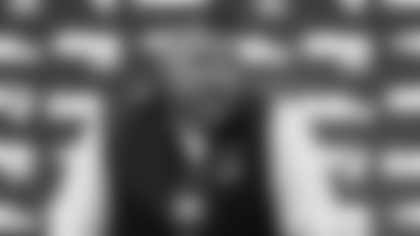What do DeMarcus Ware, Joey Porter and James Harrison have in common?
Well, besides being among the league leaders in sacks last season, each was a collegiate defensive end who transitioned into an NFL hybrid defensive end/outside linebacker. And because of the trio's success last season, NFL scouts are obsessively trying to identify the best hybrid players in the 2009 draft class.
Hybrids, who are best described as players who possess the pass-rush skills of a defensive end and the cover ability of an outside linebacker, have grown in popularity in recent years because more teams are using a 3-4 base defense. The Pittsburgh Steelers, New England Patriots and Baltimore Ravens have been 3-4 disciples for years, and their implementation of the scheme allowed them to convert undersized college defensive ends into outside linebackers with tremendous success. Pro Bowlers Willie McGinest, Mike Vrabel and Terrell Suggs are a few of the players who benefitted from playing as a hybrid-type defender in the NFL.
With 11 teams using some form of a 3-4 base defense, the need for hybrid defensive end/outside linebackers has resulted in more players being placed in this special category.
This year's draft class features as many as 10 hybrid-type players projected to come off the board in the first three rounds. Led by Brian Orakpo, Everette Brown, Aaron Maybin and Larry English, at least four hybrids likely will be taken in the first round, and that doesn't include the draft's fastest riser, Clay Matthews, who is viewed as a first-round talent by several teams.
Orakpo, who led the University of Texas with 11.5 sacks in 2008, is a phenomenal pass rusher, but he lacks the size to fight 300-pound offensive tackles on an every-down basis. Thus, NFL teams have been evaluating his ability to drop into coverage and change directions as a possible outside linebacker in a 3-4 defense.
Brown, Maybin and English also faced similar scrutiny at their pro days. Each spent the majority of his college career with his hand in the ground, but teams want to see if those three players are athletic enough to play from a two-point stance. If they are able to show the ability to function in coverage, they can be better incorporated into exotic zone-blitz schemes.
Although most of the pre-draft speculation has been on the aforementioned quartet, this draft class is stocked with other hybrids who could impact the league early in their careers. Though Michael Johnson, Connor Barwin and Lawrence Sidbury carry second-round grades, each has the potential to outplay his draft status because of his athleticism and big-play potential.
Johnson, who is one of the best athletes available at the position, is a rangy player who flashes dominant ability as a rusher off the edge. His first-step quickness is exceptional, and he can run down quarterbacks from the backside. Though his effort is inconsistent, Johnson's athleticism is undeniable, and he has the potential to terrorize opponents off the edge.
Barwin, who played tight end for three seasons at Cincinnati before switching to defensive end during his senior year, led the Big East Conference with 12 sacks and displayed impressive pass-rush skills, considering his experience. With an extensive basketball background (he played for the Bearcats' hoops squad for two seasons as a walk-on), Barwin has the athleticism to excel in coverage as a zone-dropper. That combination of athleticism and pass-rush skill makes Barwin an ideal hybrid player in zone-blitz schemes and a potential star in the right situation.
While most of the highly rated hybrid prospects played on big college stages, Sidbury toiled in relative anonymity at the University of Richmond. But after leading the Spiders to a national title in the NCAA Football Championship Series (formerly Division I-AA), Sidbury has shot up draft boards and drawn the interest of numerous teams looking to add an impact playmaker.
Sudbury, a former track athlete, has explosive initial quickness and flashes a tremendous closing burst. Though he has a tendency to run around blocks at times, his ability to get to the quarterback is impressive and makes him a highly regarded prospect as an edge rusher.
The renaissance of the 3-4 defense has changed the landscape of the draft because hybrid defensive ends/outside linebackers have become highly desirable prospects. With scores of versatile athletes manning the defensive end position in college, it appears the 2009 draft class will offer more than enough hybrid candidates.
| Top 10 hybrid defensive ends/outside linebackers | |||||
| Rank | Player | School | Height | Weight | Projected round |
| 1. | Brian Orakpo | Texas | 6-3 | 263 | 1 |
|
**  Analysis:** A high-motor pass rusher with outstanding speed and quickness, Orakpo uses an explosive first step and an impressive array of athletic moves to defeat blockers on the edge. During his senior season, he absolutely disrupted opponents' game plans with his phenomenal rush skills. Although Orakpo's stiffness causes some scouts to question his ability to drop into pass coverage as a 3-4 linebacker, his outstanding pass-rush ability far outweighs his negatives and makes him the premier hybrid player on the board. NFL landing spot: The Kansas City Chiefs (No. 3), Cleveland Browns (No. 5) and Green Bay Packers (No. 9) are 3-4 teams that need a pass rusher of Orakpo's caliber. | |||||
| * * * | |||||
| Rank | Player | School | Height | Weight | Projected round |
| 2. | Everette Brown | Florida State | 6-2 | 274 | 1 |
|
**  Analysis:** Brown has the speed and quickness to be a disruptive force off the edge. Blessed with an exceptional first step, Brown routinely defeats blockers with upfield rushes. While some scouts have labeled him a "one-trick" pony because of his extensive use of the speed rush, his outstanding production (13.5 sacks and four forced fumbles as a junior in 2008) indicates that he is capable of being a difference-maker off the edge. As a designated rusher in a 3-4 or 4-3 defense, Brown should provide plenty of highlights and impact plays off the edge. NFL landing spot: The Packers would be a great fit at No. 9, but their disappointing history with Florida State defensive ends (Jamal Reynolds, a first-round pick in 2001) might lead them to pass. Therefore, Brown could land with the Buffalo Bills (No. 11), Denver Broncos (No. 12) or Washington Redskins (No. 13) to upgrade their respective pass rushes. | |||||
| * * * | |||||
| Rank | Player | School | Height | Weight | Projected round |
| 3. | Aaron Maybin | Penn State | 6-4 | 249 | 1 |
|
**  Analysis:** The All-Big Ten Conference selectee is an explosive speed rusher who shows outstanding athleticism and burst. Maybin's ability to close on quarterbacks from the backside is remarkable and a major reason why the third-year sophomore had 12 sacks in 2008. Though Maybin lacks the bulk to hold the point against the run, he is a productive "run-and-chase" player who flashes disruptive skills from the backside. Maybin isn't a polished prospect at this point, but his burgeoning potential as a pass rusher makes him an intriguing prospect as a situational edge player. NFL landing spot: The 49ers will strongly consider Maybin at No. 10, but his game is so similar to Manny Lawson's that they might elect to pass. If that scenario plays out, Maybin could fall to the Bills (No. 11), Broncos (No. 12), Redskins | |||||
| * * * | |||||
| Rank | Player | School | Height | Weight | Projected round |
| 4. | Larry English | Northern Illinois | 6-2 | 274 | 1-2 |
|
**  Analysis:** As a disruptive edge rusher with a high motor and exceptional burst, English routinely defeats blockers with his explosive first step. He pursues quarterbacks with unrelenting ferocity and amassed 30 sacks in his four-year college career. Although his detractors would downgrade his ability as a run defender, English has shown promise when matched with tight ends on play-side runs, and he has the potential to develop into an effective run stuffer. English shouldn't have a problem finding a home as a designated pass rusher in a 3-4 defense this fall. NFL landing spot: The New England Patriots need a pass-rushing threat opposite Adalius Thomas in their 3-4 defense, and English's penchant for battering quarterbacks makes him a worthy candidate at No. 23. The Miami Dolphins (No. 25) also could scoop him up as an eventual successor to Joey Porter. | |||||
| * * * | |||||
| Rank | Player | School | Height | Weight | Projected round |
| 5. | Clay Matthews | USC | 6-3 | 240 | 1-2 |
|
**  Analysis:** As a former walk-on with an outstanding motor and work ethic, Matthews is a self-made player who overwhelms opponents with his relentless passion. Though he isn't a skilled or polished pass rusher, Matthews racks up sacks because of his refusal to quit on plays. While some scouts have suggested that Matthews is possibly a "one-year wonder" based on his production during his lone season as a starter at USC, his strong performances at his workouts has even his strongest detractors projecting him to be one of the hottest prospects in the draft. NFL landing spot: Bill Belichick coached Matthews' father (also named Clay Matthews) in Cleveland and could pick the son as Mike Vrabel's replacement. If the Patriots pass at No. 23, Matthews could fall to the Cleveland Browns (No. 36) in the second round. | |||||
| * * * | |||||
| Rank | Player | School | Height | Weight | Projected round |
| 6. | Michael Johnson | Georgia Tech | 6-7 | 266 | 2 |
|
**  Analysis:** Johnson possesses all of the physical tools to be the best pass rusher in the 2009 draft class, but his inconsistent motor prevents him from posting production that matches his athletic potential. Although he finished his college career with 19 sacks, including nine as a senior, Johnson has been labeled by some as an underachiever. However, his dazzling performances at the combine and his pro day has some teams envisioning the enigmatic talent developing into a dominant pass rusher as a pro, and Johnson might sneak his way into the bottom of the first round. NFL landing spot: If Johnson climbs into the first round, the Tennessee Titans could be possible takers at No. 30. With the team's starting defensive ends (Jevon Kearse and Kyle Vanden Bosch) on the backside of their careers, Johnson could serve as an apprentice for one year before replacing one of them. | |||||
| * * * | |||||
| Rank | Player | School | Height | Weight | Projected round |
| 7. | Connor Barwin | Cincinnati | 6-4 | 256 | 2 |
|
**  Analysis:** The versatile two-way performer played tight end for three seasons, then excelled at defensive end after converting to the position in the spring before his senior year. Barwin possesses exceptional movement skills and shows natural pass-rush ability off the edge. Though he has only spent one season at the position, Barwin's technique and hand skills are impressive, considering his lack of experience. With more time at the position, most scouts believe Barwin can develop into a legitimate pass rusher in the NFL. NFL landing spot: The ultra-athletic Barwin will be an enticing prospect for teams that use a 3-4 defense and need a legitimate pass rusher in the second round. | |||||
| * * * | |||||
| Rank | Player | School | Height | Weight | Projected round |
| 8. | Lawrence Sidbury | Richmond | 6-3 | 266 | 2-3 |
|
**  Analysis:** An explosive athlete with an exceptional first step and burst, Sidbury dominated the NCAA Football Championship Series (formerly Division I-AA) as a senior, racking up 11.5 sacks and repeatedly harassing quarterbacks off the edge with an assortment of speed rushes. While Sidbury's lack of bulk renders him ineffective as a power player at times, his ability to turn speed into power allows him to compensate for his size deficiency. Though it will take some time for Sidbury to transition into a 3-4 edge rusher in the NFL, his potential and upside makes him one of the draft's biggest sleepers. NFL landing spot: Sidbury is a highly coveted prospect who is flying up draft boards because of his superior athleticism. Teams such as the Browns, Dolphins and Baltimore Ravens could be possible suitors in the second round.
| |||||
| * * * | |||||
| Rank | Player | School | Height | Weight | Projected round |
| 9. | Cody Brown | Connecticut | 6-2 | 244 | 3 |
|
**  Analysis:** The All-Big East Conference selectee is projected to move to outside linebacker after a stellar career at defensive end in college. A long, rangy athlete with surprising athleticism, Brown excels at crashing off the edges. Though he lacks the bulk to play a power game, he does a good job of using his length to defeat blockers with an array of combative hand movements. Brown possesses the athleticism to be an effective in coverage and could develop into a multi-purpose threat as an edge player. With good upside and potential, Brown figures to be a coveted player on draft day. NFL landing spot: Brown's athleticism is so enticing that teams will seriously consider taking him off the board at the beginning of the draft's second day. | |||||
| * * * | |||||
| Rank | Player | School | Height | Weight | Projected round |
| 10. | David Veikune | Hawaii | 6-3 | 257 | 3 |
|
**  Analysis:** The energetic pass rusher has an explosive first step and good closing quickness. Although he isn't a fluid athlete, Veikune relied on a blue-collar approach to register nine sacks during his senior season. While some scouts question whether he is explosive enough to become a double-digit sack artist in the NFL, Veikune's unrelenting passion to get to the quarterback makes him a credible threat off the edge. Veikune needs time to develop into a functional dropper in coverage, but his motor and toughness will make him a desirable 3-4 edge player. NFL landing spot: There's always a roster spot for a high-motor player with pass-rush skills. Though Veikune's pro position is debatable, he will come off the board in Round 3 as a potential rotational player.
This article has been reproduced in a new format and may be missing content or contain faulty links. Please use the Contact Us link in our site footer to report an issue.
Latest News
Presented by
Trending VideoIn Case You Missed It
Presented by
| |||||









































